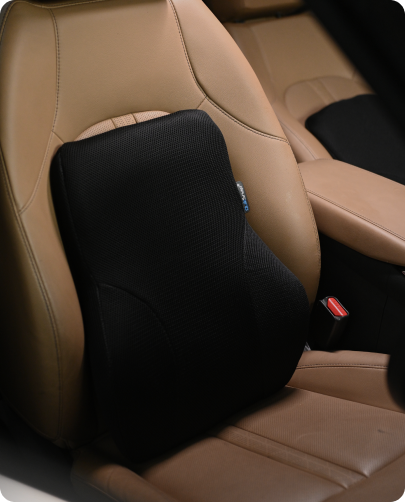
Common Mistakes to Avoid When Using Lumbar Support in Cars
Share
People delay their trips endlessly to far-off places because driving for long periods can exhaust your back as well as your mind, especially if you are not careful with your posture and the quality of your seat. While lumbar support in cars is a game-changer for maintaining proper alignment and reducing strain, many people don’t use it effectively. Avoiding a few common mistakes can ensure that your back support for the car seat works its magic, keeping you pain-free and comfortable even on the longest drives.
1. Improper Placement of Lumbar Support
One of the most frequent mistakes drivers make is placing the lumbar support too high or too low. To maximize its benefits, the lumbar cushion or support built into your car seat should align with the natural curve of your lower back. Misalignment can lead to discomfort and even cause more strain on your spine in the long run. Adjust your lumbar support in cars to ensure it's installed in the right spot to prevent unnecessary aches.
2. Overusing Lumbar Support
Yes, there is such a thing as too much of a good thing. Excessive pressure from an over-padded lumbar support can force your spine into an unnatural position, leading to discomfort over time. It’s crucial to strike a balance—enough support to maintain the natural curve of your spine without pushing it out of rhythm.
3. Ignoring Personal Comfort Needs
Not all backs are created equal, and the best lumbar support in cars for one person might not work for another. Some people might need softer support, while others benefit from firmer cushions. Additionally, the type of vehicle you drive plays a role in what works best. For example, truck drivers might require more robust back support for car seats, while Toyota car owners might prefer a slimmer profile. Always prioritize what feels right for your body.
4. Not Pairing Lumbar Support with Proper Posture
Using lumbar support in cars is only half of the win. Poor posture, such as slouching or leaning forward, negates the benefits of lumbar cushioning. Ensure your seat is adjusted to allow your back to rest fully against the support, your knees are slightly bent, and your head is in a neutral position. Combining proper posture with well-placed lumbar support is the ultimate recipe for a comfortable ride.
5. Failing to Adjust for Long Drives
Your body’s needs can change over a long trip. What feels comfortable during the first hour might become less effective after several hours of driving. Many people forget to reassess their lumbar support during extended journeys, leading to unnecessary stiffness. Make it a habit to take short breaks, stretch, and readjust your back support for the car seat to stay comfortable and also avoid the so-called ‘highway hangover’.
6. Overlooking Quality
Investing in high-quality lumbar support for car seats is essential. A poorly made cushion or built-in support that loses its shape over time can do more harm than good. Look for durable materials like memory foam or firm, recyclable polyester for long-lasting support. High-quality lumbar cushions not only maintain their shape but also adapt quickly to your body.
7. Assuming All Car Seats Have Adequate Lumbar Support
Many modern cars come with built-in lumbar support, but they’re not always sufficient for everyone. Some designs are too rigid or fail to align with the natural curve of your spine. If your car’s built-in support doesn’t meet your needs, consider adding an external back support for the car seat to customize your setup.
8. Neglecting Maintenance
Like any accessory, your lumbar support for car seat requires care and maintenance. Over time, dirt, sweat, and general wear can degrade the material, reducing its effectiveness. Clean your lumbar cushion regularly and check for signs of getting worn out. A well-maintained cushion ensures a consistent payback, making it worth the extra effort.
